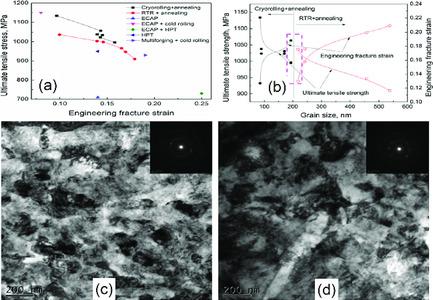当前位置:
X-MOL 学术
›
Adv. Eng. Mater.
›
论文详情
Our official English website, www.x-mol.net, welcomes your
feedback! (Note: you will need to create a separate account there.)
Microstructural Evolution and Mechanical Properties of Ultrafine‐Grained Ti Fabricated by Cryorolling and Subsequent Annealing
Advanced Engineering Materials ( IF 3.4 ) Pub Date : 2020-06-05 , DOI: 10.1002/adem.201901463 Hailiang Yu 1, 2, 3 , Lin Wang 1, 2, 3 , Ming Yan 4 , Hao Gu 1, 2, 3 , Xing Zhao 1, 2, 3 , Charlie Kong 5 , Yu Wang 5 , Alexander Pesin 6 , Alexander P. Zhilyaev 6 , Terence G. Langdon 7
Advanced Engineering Materials ( IF 3.4 ) Pub Date : 2020-06-05 , DOI: 10.1002/adem.201901463 Hailiang Yu 1, 2, 3 , Lin Wang 1, 2, 3 , Ming Yan 4 , Hao Gu 1, 2, 3 , Xing Zhao 1, 2, 3 , Charlie Kong 5 , Yu Wang 5 , Alexander Pesin 6 , Alexander P. Zhilyaev 6 , Terence G. Langdon 7
Affiliation

|
Ultrafine‐grained (UFG) commercial purity titanium (CP Ti) has a significant potential for use in medical implants and aerospace structural parts. Herein, UFG CP Ti sheets are processed by cryorolling and room‐temperature rolling (RTR), respectively, followed by annealing for 1 h at temperatures from 250 to 350 °C. The grain size is reduced from ≈75 μm to ≈85 and ≈220 nm after cryorolling and RTR, respectively. The results show that the curves of tensile stress versus engineering failure strain for samples subjected to cryorolling and subsequent annealing are above those for samples subjected to RTR and subsequent annealing. In addition, the curves of ultimate tensile stress × fracture elongation versus grain size after cryorolling and annealing are above those for RTR and annealing. It is demonstrated that a combination of cryorolling and annealing leads to improved toughness compared with the processing by RTR and annealing.
中文翻译:

低温轧制和随后退火制备的超细晶粒Ti的组织演变和力学性能
超细颗粒(UFG)商业纯度钛(CP Ti)具有用于医疗植入物和航空航天结构部件的巨大潜力。此处,UFG CP Ti板分别通过低温轧制和室温轧制(RTR)进行处理,然后在250至350°C的温度下退火1小时。冷冻轧制和RTR后,晶粒尺寸分别从约75μm减小至约85 nm和约220 nm。结果表明,经受冷轧和随后退火的样品的拉伸应力对工程破坏应变的曲线高于经受RTR和随后退火的样品的曲线。另外,冷轧和退火后的极限拉伸应力×断裂伸长率与晶粒尺寸的关系曲线高于RTR和退火的关系。
更新日期:2020-06-05
中文翻译:

低温轧制和随后退火制备的超细晶粒Ti的组织演变和力学性能
超细颗粒(UFG)商业纯度钛(CP Ti)具有用于医疗植入物和航空航天结构部件的巨大潜力。此处,UFG CP Ti板分别通过低温轧制和室温轧制(RTR)进行处理,然后在250至350°C的温度下退火1小时。冷冻轧制和RTR后,晶粒尺寸分别从约75μm减小至约85 nm和约220 nm。结果表明,经受冷轧和随后退火的样品的拉伸应力对工程破坏应变的曲线高于经受RTR和随后退火的样品的曲线。另外,冷轧和退火后的极限拉伸应力×断裂伸长率与晶粒尺寸的关系曲线高于RTR和退火的关系。











































 京公网安备 11010802027423号
京公网安备 11010802027423号